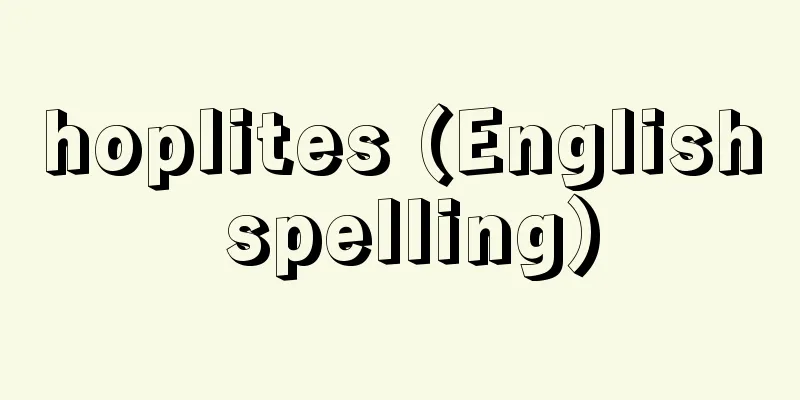Muromachi Shogunate

|
A military government led by the Ashikaga clan. In 1378 (Tenju 4/Eiwa 4), the third Shogun, Yoshimitsu, built his residence in Muromachi, Kitakoji, Kyoto (Kamigyo Ward, Kyoto City) and made it the center of government, hence the name. It is also called the Ashikaga Shogunate. [Kouen Kuwayama] EstablishedSome say it was in 1338 (Engen 3, Ryakuo 1), the year Ashikaga Takauji was appointed Seii Taishogun, but the commonly accepted theory is that it was in November 1303 (Engen 1, Kenmu 3), the year the Sacred Treasures were handed over between Emperor Godaigo and Emperor Komyo and the Kenmu Code, which could be considered the shogunate's policy outline, was established. Evidence can be found that the shogunate's main government offices, such as the Hikitsukekata, Samuraidokoro, Mandokoro, and Monchujo, were all active from around 13036 or 13037. [Kouen Kuwayama] The nature of the governmentWhen the shogunate was first established, it considered the period of Hojo Yoshitoki and Hojo Yasutoki, said to be the heyday of the Kamakura shogunate's regent politics, as its model, as clearly stated in the Kenmu Code. Many of the institutions and officials from the Kamakura shogunate period were inherited as they were, and the Goseibai Code and additional laws of the Kamakura shogunate were respected as precedents for samurai law. By the time of the third shogun, Yoshimitsu, the Muromachi shogunate's unique system was taking shape, as symbolized by the fact that the Hyojo and Hikitsuke systems, the most important institutions of the Kamakura shogunate, had become mere formalities. Particularly notable was the fact that the shogun was centered around powerful shugo daimyo who took the lead in the shogunate government, and that they were increasingly fused with the aristocratic government. The sixth shogun, Yoshinori, followed in Yoshimitsu's footsteps but placed emphasis on a group of bureaucrats known as bugyonin (magistrates) and aimed to increase the shogun's power relative to that of the shugo, but was thwarted by the Kakitsu War. During the time of the eighth shogun, Yoshimasa, the Onin War broke out, primarily motivated by conflict between powerful shugo. From the second half of the 15th century onwards, the shogunate maintained its traditional authority as the head of the samurai class and was a source of authority for the shugo daimyo, but in everyday life it played a major role as a local government in the Kinai region. [Kouen Kuwayama] The early ShogunateThe early days of the shogunate were led by two men: the first shogun Takauji, who was a political leader who succeeded in overthrowing the Kenmu government and establishing a new government, and his younger brother Tadayoshi, who displayed outstanding skills as an organizer of the power structure. It was a so-called diarchy of Takauji and Tadayoshi. Following the example of the Kamakura shogunate, they placed shugo (military governors) in each province, and in Kamakura they placed Takauji's son Yoshiakira, followed by Motouji and his descendants as Kanto kubo (Kamakura Imperial Palace, Kamakura kubo), Oshu tandai (Oshu Tandai) in Mutsu, Ushu tandai (Ushu Tandai) in Dewa, and Kyushu tandai (Kyushu Tandai) in Kyushu. During the Kamakura period, the Shugo were merely local officials with limited authority, but in this era they strengthened their military command over the samurai under their control, while at the same time invading manors through the imposition of hanzei (half tax), shugouke (request for shugo), and tansen (tax on tribute), and became feudal lords known as Shugo Daimyo. It was in 1350 (Shohei 5, Kanno 1) that the political balance between Takauji and Tadayoshi was upset, and their conflict and strife became decisive. This is called the Kanno Disturbance, named after the era name. [Kouen Kuwayama] Shogun and Shugo DaimyoIn 1368 (Shohei 23, Oan 1) when the third Shogun, Yoshimitsu, became Shogun, the Shiba clan based in Hokuriku and the Hosokawa clan of Shikoku formed the two major powers, and the Shogunate reigned on a balanced basis. Yoshimitsu initially appointed a member of the Hosokawa clan (Yoriyuki) as Kanrei (regent), in accordance with the will of his father Yoshiakira, but when the Hosokawa clan resigned in the political upheaval of 1379 (Tenju 5, Koryaku 1), he appointed a member of the Shiba clan (Yoshimasa) as Kanrei. Eventually, policies were implemented to weaken the power of powerful shugo by pitting them against each other, leading to the loss of power of the Toki clan (division of the shugo of the three provinces of Nobi-Ise), Yamana clan (Meitoku Rebellion), Imagawa clan (dismissal of Imagawa Ryoshun as Kyushu tandai), and Ouchi clan (Oei Rebellion). Yoshimitsu's successor, the fourth shogun Yoshimochi, appointed the Hatakeyama clan as kanrei for the first time, and kept the Hosokawa and Akamatsu clans in check. Meanwhile, in the Kanto region, the Kanto kubō, who had been in Kamakura since the establishment of the shogunate, was showing signs of becoming more independent vis-à-vis Kyoto. In 1416 (Oei 23), conflict arose within the Kanto Kanrei Uesugi clan, which was also entangled in speculation over who would succeed the shogun, and a coup d'état led by the former Kanrei Uesugi Zenshu drove Kanto kubo Mochiuji out of Kamakura (the Uesugi Zenshu Rebellion). Yoshimochi died without having appointed a successor to the 5th shogun Yoshikazu, who had died young. The sixth Shogun, Yoshinori, was chosen by lottery from among Yoshimitsu's sons who had entered the Buddhist priesthood, and there are signs that he made an effort to break the gloomy atmosphere of the Yoshimochi era by placing emphasis on the bureaucratic group of direct vassals known as magistrates, but he gradually began to interfere in the family disputes of the Imagawa, Takeda, and Kobayakawa clans, and he also excluded many nobles and samurai over petty matters. The direct trigger was the issue of how to treat the Akamatsu clan, which led to Yoshinori's assassination at a banquet at the Akamatsu residence in 1441 (Kakitsu 1) (the Kakitsu Rebellion). The seventh shogun, Yoshikatsu, and the eighth shogun, Yoshimasa, who were supported after Yoshinori, were both minors when they assumed the position of shogun, so the council system among the powerful shugo was restored for a while. However, from 1457 (Choroku 1), when Yoshimasa came of age and began to rule personally, interference in the affairs of the various families once again became more intense, and with the issue of the shogunal succession also becoming a problem, the Onin War broke out in 1467 (Onin 1). [Kouen Kuwayama] Shogunate FinancesThe shogunate had direct territories called bakufu-ryosho or simply goryosho, which were managed by the shogun's direct vassals. However, in reality, they were no different from manors, and regardless of the number of territories, the amount of income cannot be exaggerated. Rather, a major characteristic of the Muromachi shogunate was that it controlled merchants and industrialists in Kyoto and sought financial resources from them. In particular, large amounts of tax were collected from sake brewers and doso (warehouses) through the Nozenikata, and the amount was said to be 6,000 kan per year at the end of the 14th century. Taxes from sake brewers and doso (warehouses), which were relatively close at hand and could be collected reliably, were a major source of revenue for the shogun's daily life. In addition, although not constant, profits from trade with Japan and Ming from the 15th century onwards are also thought to have accounted for a large proportion of the shogun's income. When building Imperial Palaces or holding large-scale Buddhist and Shinto ceremonies, dansen and kuniyaku were levied on each province or specific region, and a per capita levy called shugo shussen was also made on the shugo. In the Muromachi Shogunate, which did not have a budget system, such temporary income should not be forgotten. [Kouen Kuwayama] The end of the ShogunateThe period from the Onin War, which began in 1467 and lasted for around 11 years, until the demise of the shogunate, is called the Sengoku period, in the sense that the shogunate's authority was lost and wars continued throughout the country. However, from Yoshimasa to the ninth shogun Yoshihisa, the shogun still had influence over the shugo. It was during this period that the famous Higashiyama mountain villa (later Jisho-ji Temple, of which Ginkakuji is a part) was built, and many shugo subsidized the construction costs at the shogun's command. If we look at the significance of the shogunate in terms of the relationship between the shogun and the shugo, some have suggested that the turning point should have been around 1494 (Meiō 3), when the 10th shogun Yoshiki (later Yoshitada and Yoshitane) was pursued by Hosokawa Masamoto, and Yoshitaka (later Yoshizumi), who was supported by Masamoto, became shogun. Driven out of Kyoto, Yoshitada turned to the Ouchi clan, who shared power with the Hosokawa clan in western Japan, and in 1508 (Eisho 5), he was restored to the position of Shogun. However, in 1521 (Taei 1), he fled in anger at the tyranny of Hosokawa Takakuni, and the young Yoshiharu became the 12th Shogun. From this point onwards, through the time of the 13th Shogun Yoshiteru and the 14th Shogun Yoshihide, it is often said that the position of Shogun was only in name, and that real power was held by the Hosokawa clan, and subsequently by their vassals the Miyoshi and Matsunaga clans. However, it is interesting to note when considering what the Muromachi Shogunate was, that there were also daimyo who admired the authority of the Shogun and maintained friendly relations with them, such as the Asakura clan of Echizen and the Uesugi clan of Echigo. In particular, the 15th Shogun, Yoshiaki, was initially supported by Oda Nobunaga and became Shogun, but when he fell out of accord with Nobunaga, he tried to unite the anti-Oda forces, such as the Mori, Asakura, Takeda, and Ishiyama Hongan-ji, and although his political power was weakened, it was impossible to ignore. However, in 1573 (Tensho 1), Yoshiaki was driven out of Kyoto, and the Muromachi Shogunate was destroyed in both name and reality. [Kouen Kuwayama] "History of the Northern and Southern Courts Period" by Tanaka Yoshinari (1922, Meiji Shoin/Kodansha Academic Library)" ▽ "History of the Ashikaga Period" by Tanaka Yoshinari (1923, Meiji Shoin/Kodansha Academic Library)" ▽ "History of the Muromachi Period" by Watanabe Yosuke (1948, Sogensha)" ▽ "History of Japan 9: The Turmoil of the Northern and Southern Courts" by Sato Shinichi (1965, Chuokoron-Shinsha)" ▽ "The Southern and Northern Courts" by Hayashiya Tatsusaburo (1967, Sogensha)" ▽ "The Muromachi Shogunate in the Warring States Period" by Imaya Akira (1975, Kadokawa Shoten)" ▽ "A Theory of the Muromachi Shogunate" by Sato Shinichi (included in Iwanami Lecture Series: Japanese History: Middle Ages 3, 1963, Iwanami Shoten)" ▽ "The Muromachi Shogunate" by Akamatsu Toshihide (included in Systematic Japanese History Series: Political History I, 1965, Yamakawa Publishing) ▽ "The Onin and Bunmei Wars by Kesao Momose" (included in "Iwanami Lectures on Japanese History: Middle Ages 3"; 1976, Iwanami Shoten) [References] | | | | | |"Portrait of Ashikaga Takauji, Warrior on Horseback" (traditional copy owned by the Historiographical Institute, University of Tokyo) © Historiographical Institute, University of Tokyo "> Ashikaga Takauji "Portrait of Ashikaga Yoshimitsu" Copy owned by the Historiographical Institute, University of Tokyo © Historiographical Institute, University of Tokyo "> Yoshimitsu Ashikaga "Portrait of Ashikaga Yoshimasa" (attributed) Partial copy owned by the Historiographical Institute, University of Tokyo © Historiographical Institute, University of Tokyo "> Yoshimasa Ashikaga "Portrait of Ashikaga Yoshiteru" Copy owned by the Historiographical Institute, University of Tokyo © Historiographical Institute, University of Tokyo "> Yoshiteru Ashikaga "Portrait of Ashikaga Yoshiaki" Copy owned by the Historiographical Institute, University of Tokyo © Historiographical Institute, University of Tokyo "> Yoshiaki Ashikaga Source: Shogakukan Encyclopedia Nipponica About Encyclopedia Nipponica Information | Legend |
|
足利(あしかが)氏による武家政権。1378年(天授4・永和4)3代将軍義満(よしみつ)が京都北小路室町(むろまち)(京都市上京(かみぎょう)区)に邸宅を構え、政権の中心としたことにより、このように称される。足利幕府ともいう。 [桑山浩然] 成立足利尊氏(たかうじ)が征夷(せいい)大将軍に任ぜられた1338年(延元3・暦応1)とする説もあるが、通説では、後醍醐(ごだいご)天皇と光明(こうみょう)天皇の間で神器の授受が行われ、幕府の政策大綱ともいうべき「建武式目(けんむしきもく)」が定められた36年(延元1・建武3)11月とする。幕府の主要政務機関である引付方(ひきつけかた)、侍所(さむらいどころ)、政所(まんどころ)、問注所(もんちゅうじょ)などは、いずれも36年ないし37年ころより活動の跡が認められる。 [桑山浩然] 政権の性格成立当初の幕府は、「建武式目」に明示しているように、鎌倉幕府執権(しっけん)政治全盛期といわれる北条義時(ほうじょうよしとき)・泰時(やすとき)の時期を模範と考えていた。鎌倉幕府時代の諸機関や職員の多くはそのまま継承され、鎌倉幕府の「御成敗(ごせいばい)式目」や追加法は武家法の先例として尊重された。3代義満のころになると、鎌倉幕府における最重要機関であった評定(ひょうじょう)・引付の制度が形骸(けいがい)化してくることに象徴的に示されるように、室町幕府独自の体制ができてくる。将軍を中心にして有力守護大名が幕政の主導権を握ること、公家(くげ)政権との融合が進むことがとくに目だつ点である。6代義教(よしのり)は、義満の先例を追いつつ一方で奉行人(ぶぎょうにん)とよばれる吏僚グループを重用し、守護に対して将軍権力の相対的向上を目ざしたが、嘉吉(かきつ)の乱により挫折(ざせつ)した。8代義政(よしまさ)の時期には、有力守護の対立を主要な動機に応仁(おうにん)の乱が勃発(ぼっぱつ)した。15世紀後半以降の幕府は、武家の棟梁(とうりょう)としての伝統的権威は保持し、守護大名の権威の源泉としての意味はもつものの、日常的には畿内(きない)の地方政権としての意味合いが濃い。 [桑山浩然] 初期の幕府幕府の初期は、建武政権を倒し、新しい政権の樹立に成功した政治的指導者である初代将軍尊氏と、その弟で権力機構の組織者として卓越した手腕を発揮した直義(ただよし)の2人に率いられていた。いわば尊氏、直義の二頭政治である。各国には鎌倉幕府に倣って守護を置くとともに、鎌倉には尊氏の息義詮(よしあきら)、ついで基氏(もとうじ)とその子孫を置いて関東公方(くぼう)(鎌倉御所、鎌倉公方)とし、陸奥(むつ)には奥州探題(おうしゅうたんだい)、出羽(でわ)に羽州(うしゅう)探題、九州に九州探題を置いた。鎌倉時代には限られた権限しかもたない地方官にすぎなかった守護は、この時代に入ると管下武士への軍事指揮権を強め、一方、半済(はんぜい)、守護請(うけ)、段銭(たんせん)の賦課などを通じて荘園(しょうえん)を侵略し、守護大名とよばれるように領主化していった。尊氏、直義の政治的バランスが崩れて対立、抗争が決定的になったのは1350年(正平5・観応1)である。これを年号にちなんで観応(かんのう)の擾乱(じょうらん)とよんでいる。 [桑山浩然] 将軍と守護大名3代義満が将軍になった1368年(正平23・応安1)当時は、北陸に本拠を置く斯波(しば)氏と四国の細川氏が二大勢力を形成し、将軍はその均衡のうえにのっていた。義満は初め父義詮の遺命もあって細川氏(頼之(よりゆき))を管領(かんれい)にするが、79年(天授5・康暦1)の政変(康暦(こうりゃく)の政変)により細川氏が下野すると、斯波氏(義将(よしまさ))を管領にした。やがて有力守護の同族どうしを争わせて勢力をそぐ政策がとられ、土岐(とき)氏(濃尾伊勢(いせ)三国守護の分割)、山名(やまな)氏(明徳(めいとく)の乱)、今川氏(今川了俊(りょうしゅん)の九州探題解任)、大内氏(応永(おうえい)の乱)らが勢力を失った。義満を継いだ4代義持(よしもち)は畠山(はたけやま)氏を初めて管領に登用し、細川・赤松両氏を牽制(けんせい)した。一方関東では、幕府開設以来鎌倉にいた関東公方が京都に対し自立的な動きを示していた。1416年(応永23)には関東管領上杉(うえすぎ)氏内部に対立が起こり、将軍継嗣(けいし)をめぐる思惑も絡み、前管領上杉禅秀(ぜんしゅう)のクーデターによって関東公方持氏(もちうじ)は鎌倉を追われた(上杉禅秀の乱)。義持は早逝した5代義量(よしかず)の継嗣を定めぬまま没した。 義満の仏門に入った子息のなかからくじによって将軍職に迎えられた6代義教は、奉行人とよばれる事務官僚的な直臣団を重用して、義持時代の沈滞した雰囲気の打破に努めた形跡が認められるが、しだいに今川氏、武田氏、小早川氏らの一族争いに干渉するようになり、また、ささいなことで排斥した公家(くげ)、武家も少なくなかった。赤松氏一族の処遇問題を直接のきっかけとして、1441年(嘉吉1)義教は赤松邸の遊宴の席で暗殺された(嘉吉の乱)。義教ののち擁立された7代義勝(よしかつ)、8代義政(よしまさ)は将軍職就任当時いずれも幼少であったので、しばらくは有力守護による合議制が復活したが、義政が成人に達し、親政を行うようになる57年(長禄1)以降ふたたび諸家への干渉は激しくなり、将軍継嗣問題も絡んで1467年(応仁1)には応仁の乱の勃発をみるのである。 [桑山浩然] 幕府の財政幕府には幕府料所あるいは単に御料所とよばれる直轄領があり、将軍の直臣たちが管理していた。ただしその実態は荘園と異ならず、所領の数はともかく、収入額を過大視することはできない。むしろ、京都市中の商工業者を支配下に置き、これに財源を求めたのが室町幕府の大きな特徴である。とくに酒屋、土倉(どそう)からは納銭方を通じて多額の役銭が徴収され、その額は14世紀末の段階で年額6000貫といわれている。比較的手近にあって確実に徴収できる酒屋・土倉役は将軍の日常生活をまかなう有力な財源であった。また、恒常的なものではないが、15世紀以降の日明(にちみん)貿易による利益も大きな比重を占めていたものと考えられる。御所を造営したり、大規模な仏神事を修したりする際には、諸国や特定の国に段銭や国役(くにやく)が賦課されたり、守護出銭(しゅっせん)と称して守護に対して頭割りで賦課がなされることがあった。予算制度のない室町幕府にあっては、このような臨時的な収入も忘れてはならない。 [桑山浩然] 幕府の終末1467年に始まり、前後11年に及ぶいわゆる応仁の乱以降幕府の滅亡に至る時期を、幕府の権威が失われ、全国に戦乱が続いたとの意味で戦国時代とよんでいる。しかし義政から9代義尚(よしひさ)の時期にはまだ将軍の守護に対する影響力は残っていた。有名な東山(ひがしやま)の山荘(後の慈照寺(じしょうじ)、銀閣はその一部)が造営されたのはこの時期で、多くの守護が将軍の命によって造営費用を助成している。幕府の意義を将軍と守護との関係においてみるならば、むしろ10代義材(よしき)(後の義尹(よしただ)・義稙(よしたね))が細川政元(まさもと)に追われ、政元に擁立された義高(よしたか)(後の義澄(よしずみ))が将軍となった1494年(明応3)ごろを画期とすべきであるとの意見も出されている。京都を追われた義尹は、西日本において細川氏と勢力を二分していた大内氏を頼り、1508年(永正5)には再度将軍職に復する。しかし21年(大永1)細川高国(たかくに)の専横を怒って出奔し、その後には幼少の義晴(よしはる)が12代将軍となった。これ以降13代義輝(よしてる)、14代義栄(よしひで)の時期にかけて、将軍職とは名ばかりで、実権は細川氏、ついで細川氏の家臣三好(みよし)氏・松永(まつなが)氏らに握られていたと説かれることが多いが、越前(えちぜん)の朝倉(あさくら)氏、越後(えちご)の上杉氏など将軍の権威を慕ってよしみを通ずる大名もいたことは、室町幕府のなんたるかを考えるうえで興味深いことである。ことに15代義昭(よしあき)は、初め織田信長に擁されて将軍職につくが、信長と不和になると、毛利(もうり)・朝倉・武田・石山本願寺など反織田勢力の結集に努め、衰えたりとはいえその政治力は無視することはできなかった。しかし1573年(天正1)義昭は京都を追われ、室町幕府は名実ともに滅びた。 [桑山浩然] 『田中義成著『南北朝時代史』(1922・明治書院/講談社学術文庫)』▽『田中義成著『足利時代史』(1923・明治書院/講談社学術文庫)』▽『渡辺世祐著『室町時代史』(1948・創元社)』▽『佐藤進一著『日本の歴史9 南北朝の動乱』(1965・中央公論社)』▽『林屋辰三郎著『南北朝』(1967・創元社)』▽『今谷明著『戦国期の室町幕府』(1975・角川書店)』▽『佐藤進一著「室町幕府論」(『岩波講座 日本歴史 中世3』所収・1963・岩波書店)』▽『赤松俊秀著「室町幕府」(『体系日本史叢書 政治史Ⅰ』所収・1965・山川出版社)』▽『百瀬今朝雄著「応仁・文明の乱」(『岩波講座 日本歴史 中世3』所収・1976・岩波書店)』 [参照項目] | | | | | |「足利尊氏画像 騎馬武者像」(伝) 東京大学史料編纂所所蔵模写(部分)©東京大学史料編纂所"> 足利尊氏 「足利義満画像」 東京大学史料編纂所所蔵模写©東京大学史料編纂所"> 足利義満 「足利義政画像」(伝) 東京大学史料編纂所所蔵模写(部分)©東京大学史料編纂所"> 足利義政 「足利義輝画像」 東京大学史料編纂所所蔵模写©東京大学史料編纂所"> 足利義輝 「足利義昭画像」 東京大学史料編纂所所蔵模写©東京大学史料編纂所"> 足利義昭 出典 小学館 日本大百科全書(ニッポニカ)日本大百科全書(ニッポニカ)について 情報 | 凡例 |
Recommend
Brooks, Richard
Born: May 18, 1912, Philadelphia, Pennsylvania [Di...
internal ocular muscle
...On the other hand, the function of dispersing ...
Amagi rhododendron - Amagi rhododendron
...In northern Shizuoka Prefecture, there is a sp...
Carlos I (King of Portugal)
The republicans, who strongly criticized the gove...
Navel - Belly button
[1] 〘Noun〙① The remains of the place where the umb...
Gill washing - Gill washing
...Their gill covers are so sharp that when you s...
Black marlin
…It is also called Shirokawa. Its English name is...
Dakota
...the Dakota are a people who originally lived i...
Oha Oil Field - Oha Yuden
...Population: 36,600 (1993). It is the center of...
Xiangfan
The former name of Xiangyang City in northwestern ...
Mohorovičiĉ, A.
...A branch of earth science that studies the ear...
Min'yakuyakukai - Min'yakuyakukai
This is a work by Nakae Chomin. It is a translati...
Weimar Republic (English spelling)
The first German republic was born from the Germa...
Japan Weather Association - Nihonkishokyokai (English)
A foundation that provides weather information ser...
abyssal zone
In marine biology, the deep sea refers to a depth...









